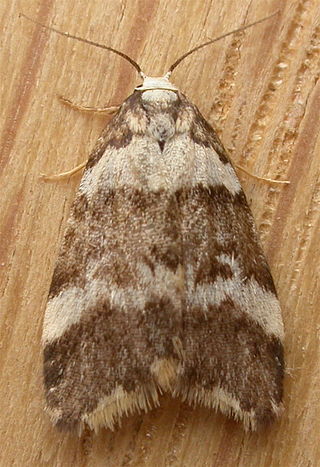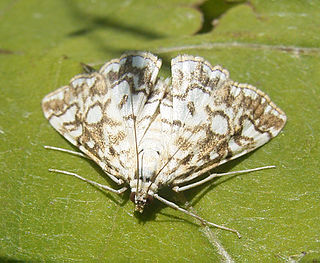
Acontiinae is a subfamily of bird dropping moths in the family Noctuidae. There are more than 50 genera and 430 described species in Acontiinae, found worldwide in temperate and tropical climates.

Amata is a genus of tiger moths in the family Erebidae. The genus was erected by Johan Christian Fabricius in 1807.

Halone is a genus of moths in the subfamily Arctiinae from southern Asia and Australia. The genus was erected by Francis Walker in 1854.

Macaduma is a genus of moths in the subfamily Arctiinae.

Halone sejuncta, the variable halone, is a moth of the subfamily Arctiinae first described by Rudolf Felder and Alois Friedrich Rogenhofer in 1875. It is found in Australia in Queensland, New South Wales, the Australian Capital Territory, Victoria, Tasmania and South Australia.

Aulacodes is a genus of moths of the family Crambidae. The genus was first described by Achille Guenée in 1854.

Loxostege is a genus of moths of the family Crambidae.

Lygropia is a genus of snout moths in the subfamily Spilomelinae of the family Crambidae. It currently comprises 66 species, which are mostly found in the tropical and subtropical regions of the Americas, Africa and Asia, but not in Australia.

Pyrausta is a speciose genus of moths of the family Crambidae. The genus was erected by Franz von Paula Schrank in 1802.

Petrophila is a genus of moths of the family Crambidae. The genus was described by Lansdown Guilding in 1830.

Catephia is a genus of moths of the family Erebidae. Most species of this genus are found in Africa.

Aphomia is a genus of small moths belonging to the family Pyralidae. Some breed in the nests of Anthophila, where their caterpillars are parasitic feeders of wax, honey and pollen.

The Alex Halone House in Thermopolis, Wyoming, United States, was built by Finnish immigrant Alex Halone for his personal residence in 1909–1910. Halone, a stonemason, built several stone structures in Thermopolis. Three generations of the Halone family were stonemasons. The grounds include a log Finnish sauna built by Alex and Eugene Halone with assistance from Lauri Suikaonen in 1946–51.

Halone prosenes, the pied halone, is a moth of the subfamily Arctiinae first described by Alfred Jefferis Turner in 1940. It is known from the Australian state of Victoria, where it is restricted to the South East Coastal Plain, South Eastern Highlands and the Victorian Volcanic Plain.

The Chrysauginae are a subfamily of snout moths. They are primarily Neotropical and include about 400 described species.

Acentropinae is a fairly small subfamily of the lepidopteran family Crambidae, the crambid snout moths. Species of this subfamily are exclusively found in wetlands and aquatic habitats.

Odontiinae is a subfamily of moths of the family Crambidae. The subfamily was described by Achille Guenée in 1854.
Halone ebaea is a moth of the subfamily Arctiinae. It was described by George Hampson in 1914. It is found in Australia.
Halone flavescens is a moth of the subfamily Arctiinae. It was described by George Hampson in 1898. It is known from Assam, India.















